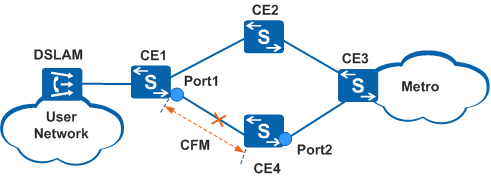Configuring Association Between CFM and an Interface
Context
A device that carries IP services is usually dual-homed to an IP network to improve network robustness and service reliability. As shown in Figure 1, CE1 connects to CE2 and CE4 through the active and standby links. To detect link connectivity, you can configure CFM between CE1 and CE4. When CFM detects a link fault, it will set the protocol status of the associated Port1 or Port2 to Down and fast switches services.
Table 1 lists association between CFM and interfaces and its usage scenarios.

A physical interface associated with CFM cannot be the one that CFM monitors. If CFM is associated with a physical interface that it monitors, the link is locked.
Association Mode |
Usage Scenario |
Description |
|
|---|---|---|---|
Association between CFM and a CFM-capable interface |
As shown in Figure 1, when CFM detects that the link between CE1 and CE2 becomes faulty, association between CFM and CFM-capable Port1 can be configured so that traffic is switched from the active link to the standby link. |
The association function is configured in the interface view and is unidirectional. That is, CFM is associated with an interface only when CFM detects a fault on the link. If CFM detects a fault, the OAMMGR module shuts down and then starts Port1 after 7s so that other modules can detect the fault. |
|
Association between CFM and a CFM-incapable interface |
As shown in Figure 1, when CFM detects that the link between CE1 and CE3 becomes faulty, association between CFM and CFM-incapable Port2 can be configured so that traffic is switched from the active link to the standby link.
|
The association function is configured in the OAM management view and is bidirectional.
|
|
Pre-configuration Tasks
Before associating CFM with an interface, perform the task of Configuring Basic Ethernet CFM Functions.
Procedure
- Configuring association between CFM and a CFM-capable interface
Run system-view
The system view is displayed.
Run interface interface-type interface-number
The view of the interface at one end of the link is displayed.
Run cfm md md-name ma ma-name remote-mep mep-id mep-id trigger if-down
CFM is associated with an interface.
By default, CFM is not associated with any interface.
(Optional) Run cfm if-down trigger ccm-send-stop
The MEP on an interface is triggered to stop sending CCMs when the interface goes Down.
By default, the MEP on an interface is not triggered to stop sending CCMs when the interface goes Down.
In a VLAN stacking scenario with an inward-facing MEP configured, if the interface where the MEP resides goes Down, to prevent the MEP from continuing to send CCMs so that other services can detect the fault information detected by CC, run the cfm if-down trigger ccm-send-stop command in the interface view.
- Configuring association between CFM and a CFM-incapable interface
Run system-view
The system view is displayed.
Run oam-mgr
The OAM management view is displayed.
Association between EFM and an EFM-incapable interface is bidirectional. Choose a configuration solution according to Table 2.
Table 2 Association between Ethernet CFM and an interface Scenario
Configuration Solution
Faults need to be transmitted bidirectionally between Ethernet CFM and an interface.
Choose either of the following commands (the two commands have the same function):
If you prefer to specify the MD and MA before the interface, use the oam-bind cfm md ma trigger if-down interface command.
If you prefer to specify the interface before the MD and MA, use the oam-bind interface cfm md ma trigger if-down command.
Faults need to be transmitted unidirectionally between Ethernet CFM and an interface.
To configure an interface to report faults to Ethernet CFM, use the oam-bind ingress interface egress cfm md ma trigger if-down command.
